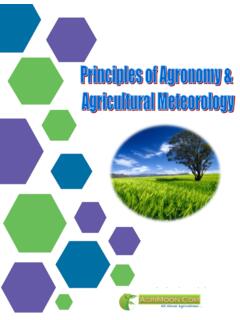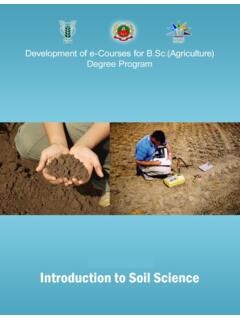Transcription of Environmental Science - AgriMoon
1 Environmental Science Environmental Science Author TNAU, Tamil Nadu Index LN Lecture Name Page 1 Scope and Importance of Environmental Studies 4-14 2 Natural resources: Renewable and Non renewable resources. Land and Water 15-23 3 Natural resources: forest, wildlife, energy and food resources 24-40 4 Ecosystems: Definition, concept, structure and functions 41-49 5 Producers, consumers and decomposers of an ecosystem. Energy flow in the ecosystem. Types of ecosystems 50-57 6 Bio-diversity: Definition, classification, threats to biodiversity and its conservation 58-68 7 Environmental pollution: Causes, effects and control of air 69-81 8 Global warming and climate change 82-102 9 Causes, effects and control of water and marine pollution 103-130 10 Causes, effects and control of soil pollution 131-140 11 Causes, effects and control of noise and thermal pollution 141-146 12 Causes, effects and management of nuclear hazards and industrial wastes 147-163 13 Disaster management, Floods, earthquakes, cyclones and land slides 164-177 14 Social issues and the environment, unsustainable to sustainable development 178-182 15 The Environment Protection Act, the Air Act, the water Act.
2 The Wildlife Protection Act and Forest Conservation Act 183-190 16 National and state level organizations - Environmental Laws and Acts Environmental Education CDM 191-200 17 Woman and child welfare, HIV/AIDS and Role of information technology on environment and human health 201-209 4 Lecture 01 Scope and Importance of Environmental Studies Environment is derived from the French word Environner, which mean encircle or surrounding. Environment is a complex of many variables, which surrounds man as well as the living organisms. Environmental studies describe the interrelationships among organisms, the environment and all the factors, which influence life on earth, including atmospheric conditions, food chains, the water cycle, etc.
3 It is a basic Science about our earth and its daily activities, and therefore, this Science is important for one and all. Scope of Environmental studies Environmental studies discipline has multiple and multilevel scopes. This study is important and necessary not only for children but also for everyone. The scopes are summarized as follows: The study creates awareness among the people to know about various renewable and nonrenewable resources of the region. The endowment or potential, patterns of utilization and the balance of various resources available for future use in the state of a country are analysed in the study.
4 It provides the knowledge about ecological systems and cause and effect relationships. It provides necessary information about biodiversity richness and the potential dangers to the species of plants, animals and microorganisms in the environment. The study enables one to understand the causes and consequences due to natural and main induced disasters (flood, earthquake, landslide, cyclones etc.,) and pollutions and measures to minimize the effects. It enables one to evaluate alternative responses to Environmental issues before deciding an alternative course of action. The study enables environmentally literate citizens (by knowing the Environmental acts, rights, rules, legislations, etc.)
5 To make appropriate judgments and decisions for the protection and improvement of the earth. The study exposes the problems of over population, health, hygiene, etc. and the role of arts, Science and technology in eliminating/ minimizing the evils from the society. The study tries to identify and develop appropriate and indigenous eco-friendly skills and technologies to various Environmental issues. It teaches the citizens the need for sustainable utilization of resources as these resources are inherited from our ancestors to the younger generating without deteriorating their quality. The study enables theoretical knowledge into practice and the multiple uses of environment.
6 Environmental Science 5 Importance of Environmental study Environmental study is based upon a comprehensive view of various Environmental systems. It aims to make the citizens competent to do scientific work and to find out practical solutions to current Environmental problems. The citizens acquire the ability to analyze the Environmental parameters like the aquatic, terrestrial and atmospheric systems and their interactions with the biosphere and anthrosphere. Importance World population is increasing at an alarming rate especially in developing countries. The natural resources endowment in the earth is limited.
7 The methods and techniques of exploiting natural resources are advanced. The resources are over-exploited and there is no foresight of leaving the resources to the future generations. The unplanned exploitation of natural resources lead to pollution of all types and at all levels. The pollution and degraded environment seriously affect the health of all living things on earth , including man. The people should take a combined responsibility for the deteriorating environment and begin to take appropriate actions to space the earth. Education and training are needed to save the biodiversity and species extinction.
8 The urban area, coupled with industries, is major sources of pollution. The number and area extinct under protected area should be increased so that the wild life is protected at least in these sites. The study enables the people to understand the complexities of the environment and need for the people to adapt appropriate activities and pursue sustainable development, which are harmonious with the environment. The study motivates students to get involved in community action, and to participate in various Environmental and management projects. It is a high time to reorient educational systems and curricula towards these needs.
9 Environmental studies take a multidisciplinary approach to the study of human interactions with the natural environment. It integrates different approaches of the humanities , social sciences, biological sciences and physical sciences and applies these approaches to investigate Environmental concerns. Environmental study is a key instrument for bringing about the changes in the knowledge, values, behaviors and lifestyles required to achieve sustainability and stability within and among countries. Environmental studies deals with every issue that affects an organism. It is essentially a multidisciplinary approach that brings about an appreciation of our natural world and human impacts 6 on its integrity.
10 It is an applied Science as it seeks practical answers to making human civilization sustainable on the earth's finite resources. Its components include Biology Geology Chemistry Physics Engineering Sociology Health Anthropology Economics Statistics Philosophy Major Environmental issues Man and nature have lived together and as long as man s wants were in conformity with nature, there was no problem. But unfortunately, man s ambition for limitless enjoyment and comfort has led him towards the exploitation of nature s wealth so indiscriminately as to reduce nature s capacity for self stabilization.













